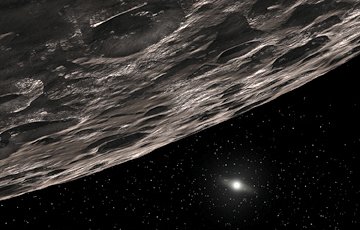Icy Orbs at the Solar System’s Edge
A ring at the solar system's outskirts appears to contain smaller objects than expected.
By Emily Sohn
Astronomers have to do lots of guesswork. They study many things that they can’t see very well, so they have to make educated assumptions based on various clues and observations. Sometimes, those assumptions turn out to be wrong.
The Kuiper belt is a perfect example. This ring of objects sits way out on the edge of our solar system. Comets come out of it. The planet Pluto may be part of it. And scientists have long thought that the belt had a lot of big objects. Pluto, for instance, is 2,400 kilometers across. Plenty of other objects out there might be close to 1,000 kilometers across.
 |
|
In this illustration by an artist, the distant sun looks like a star, as seen from near an icy object in the solar system’s Kuiper belt.
|
| JPL/NASA |
Or maybe not, says a group of researchers from the University of Arizona in Tucson. Their research now shows that many Kuiper belt objects may be much smaller than scientists previously thought.
Objects that are this small and far away can’t be measured directly. Instead, astronomers usually estimate the size of a Kuiper belt object by how bright it is and how well its surface reflects light. Their calculations depend on the known connection between brightness and the size of comets that have supposedly left the belt and moved toward Earth.
New observations, however, show that Kuiper belt objects reflect light three times better than comets do. This means that the objects are much smaller than their brightness seemed to indicate. They may be only 60 percent of the size they were thought to be.
Suddenly, astronomers are confused about all sorts of things. One popular theory holds that there used to be a lot more stuff in the Kuiper belt than there is now, but no one knows where it all went. Now, there are even more missing objects to account for.—E. Sohn
Going Deeper:
Shiga, David. 2004. Belt tightening: Icy orbs are surprisingly small. Science News 166(Nov. 20):326. Available at http://www.sciencenews.org/articles/20041120/fob7.asp .
McDonagh, Sorcha. 2004. Catching a comet’s tail. Science News for Kids (Jan. 14). Available at http://www.sciencenewsforkids.org/articles/20040114/Note2.asp .
Sohn, Emily. 2004. Saturn’s new moons. Science News for Kids (Aug. 25). Available at http://www.sciencenewsforkids.org/articles/20040825/Note3.asp .
______. 2004. Planets on the edge. Science News for Kids (April 7). Available at http://www.sciencenewsforkids.org/articles/20040407/Feature1.asp .
______. 2003. Sky dust keeps falling on your head. Science News for Kids (Aug. 13). Available at http://www.sciencenewsforkids.org/articles/20030813/Feature1.asp .
You can learn more about the Kuiper belt at solarsystem.nasa.gov/planets/profile.cfm?Object=KBOs&Display=Kids (NASA).







